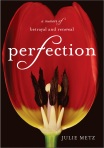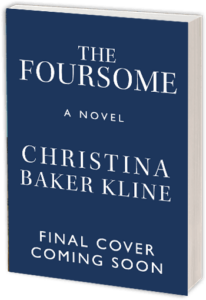 Writer Julie Metz offers some hard-won advice:
Writer Julie Metz offers some hard-won advice:
Like many of you, I am working on a new writing project, a novel. What made me think I could do this, anyway? But here I am, too far in to let go, committed to my characters. Some days are thrilling, but lately I often find myself stuck, wondering how I will push out the next sentence.
My first book, published last year, was a memoir titled Perfection. The great thing about writing a memoir is that you know the story; the art is in the writing. With fiction one has that same challenge but in addition the pesky problem of not really knowing where it’s all going to end, or, for that matter, what’s happening in the beginning or middle either.
So here’s what keeps me going on the dark writing days:
1. Reading a very good novel. At first, as I am reading the very good novel, I’m filled with self-loathing and fear of failure. Wow, this book is so effing amazing, I’ll never be able to write anything like this! But then I relax and begin to enjoy and finally adore the world the author has created, and to see that we all can create our own worlds. I won’t be writing a novel about the day a tightrope walker crossed the space between the World Trade Towers, but I might be able to write a good book about something else. Like a demanding but inspiring teacher, a good book elevates my day-to-day language and my life.
2. Exercise. While I might tell myself that I don’t have time to take care of my body, because I should be busy writing, taking time to keep fit helps my mind work so much better. I have begun the year with frequent trips to the gym, which I hope will help me through the winter doldrums. It’s a cliché that our body is our home. Right now I feel like my body is my home office. If I can keep it clean and tidy, there is room for clearer thinking and perhaps some inspiration.
3. Accidental moments of insight. Just when I think it can’t get worse, that I’ll never write a decent sentence again, that my first book was a weird fluke and now I am doomed, doomed, doomed to utter failure, I’ll have some odd revelatory moment about my story and characters. Often it’s feedback from one of my readers that I have been resisting (grumpily), but suddenly realize is fantastically clear and true. Other times there’ll be some small moment out in the world, a scene at the grocery store or an encounter with a friend in my neighborhood, that allows me to understand a character or scene. These moments help me clarify a point, and then I can move on. Not at the pace I wish, but I move on nonetheless.
Julie Metz, a memoirist, book designer, and soon-to-be novelist, is a frequent contributor to this blog.













 From left to right: Rosalind Reisner (co-moderator), C.M. Mayo, Julie Metz, Eva Hoffman, Christina Baker Kline, Roxana Robinson, and Miriam Tuliao (co-moderator).
From left to right: Rosalind Reisner (co-moderator), C.M. Mayo, Julie Metz, Eva Hoffman, Christina Baker Kline, Roxana Robinson, and Miriam Tuliao (co-moderator). Can you give examples of some book covers you particularly like? Just a very few of the smart, clever covers I personally admire include all of David Sedaris, Lorrie Moore’s Birds of America, Nabokov’s Short Stories, J.M. Coetzee’s all-white novels (stark, spare, just like his writing). I have a small but cherished collection of book covers designed by greats like
Can you give examples of some book covers you particularly like? Just a very few of the smart, clever covers I personally admire include all of David Sedaris, Lorrie Moore’s Birds of America, Nabokov’s Short Stories, J.M. Coetzee’s all-white novels (stark, spare, just like his writing). I have a small but cherished collection of book covers designed by greats like 




 I
I  The Dracula Dossier is a fun read, and the cover was fun to design. The challenge was putting together pieces from several images to make it all look like one universe. The story takes place in London during the time of Jack the Ripper, and the theater plays a big part in the story. I think the curtain adds mystery and some information for the reader about the setting.
The Dracula Dossier is a fun read, and the cover was fun to design. The challenge was putting together pieces from several images to make it all look like one universe. The story takes place in London during the time of Jack the Ripper, and the theater plays a big part in the story. I think the curtain adds mystery and some information for the reader about the setting. The poems in Charlie Smith’s Word Comix are engaging and full of fantastic imagery, and I wanted to treat the cover as if the book were a novel. The author suggested the Western element, and when I found this picture I knew my work was done. I added some elements to give it a more gravity-defying feel. I love doing hand-lettering whenever I can get away with it.
The poems in Charlie Smith’s Word Comix are engaging and full of fantastic imagery, and I wanted to treat the cover as if the book were a novel. The author suggested the Western element, and when I found this picture I knew my work was done. I added some elements to give it a more gravity-defying feel. I love doing hand-lettering whenever I can get away with it. We designers live for the AIGA “50 covers 50 books” show, and I am proud that this Ezra Pound cover won a spot in the show. As I mentioned, I love doing hand-lettering – and it seemed so appropriate for this collection of correspondence. I tried to give it an edgy, desperate feeling.
We designers live for the AIGA “50 covers 50 books” show, and I am proud that this Ezra Pound cover won a spot in the show. As I mentioned, I love doing hand-lettering – and it seemed so appropriate for this collection of correspondence. I tried to give it an edgy, desperate feeling. I hired a picture researcher to help me with the cover for Inheritance. She had a friend whose mother had grown up in China at the right time, and there were family photos. We did some hand-coloring, and I tried to channel my inner calligrapher.
I hired a picture researcher to help me with the cover for Inheritance. She had a friend whose mother had grown up in China at the right time, and there were family photos. We did some hand-coloring, and I tried to channel my inner calligrapher. The title of Barbara Gowdy’s novel The Romantic is somewhat ironic, so I wanted to find an image that showed the edgier, sharper side of love.
The title of Barbara Gowdy’s novel The Romantic is somewhat ironic, so I wanted to find an image that showed the edgier, sharper side of love. A book cover I wish I had been paid royalties for, because it has withstood the test of time: The Poisonwood Bible by Barbara Kingsolver. When the art director assigned the job, he said that the mission was to take the author out of what might be called “genre” fiction to something wider. I read the book and loved it. I purchased Bible paper and organized a photo shoot to create the book for the background. I chose elegant, classic type, as we all saw this novel as a modern classic. But the cover was still missing something. At 2 am (this was long before I had a baby, and my freelancer hours were night-owlish), I was fretting over the design in progress. My then-husband said he felt it needed a human element.
A book cover I wish I had been paid royalties for, because it has withstood the test of time: The Poisonwood Bible by Barbara Kingsolver. When the art director assigned the job, he said that the mission was to take the author out of what might be called “genre” fiction to something wider. I read the book and loved it. I purchased Bible paper and organized a photo shoot to create the book for the background. I chose elegant, classic type, as we all saw this novel as a modern classic. But the cover was still missing something. At 2 am (this was long before I had a baby, and my freelancer hours were night-owlish), I was fretting over the design in progress. My then-husband said he felt it needed a human element. Was it harder or easier than usual to design your own book cover?It was harder! I felt like I had so much on the line. I wrote a piece about this for the May 25, 2009 edition of Publishers Weekly titled
Was it harder or easier than usual to design your own book cover?It was harder! I felt like I had so much on the line. I wrote a piece about this for the May 25, 2009 edition of Publishers Weekly titled 
